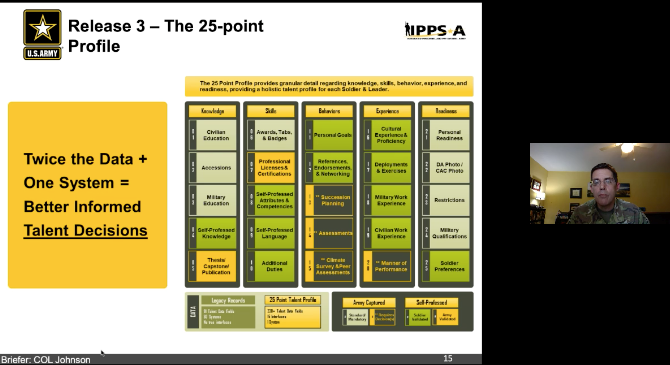Army readies its three components for new, cutting-edge HR system

WASHINGTON, D.C.—Soldiers and Department of the Army civilians tuned into Microsoft Teams on Monday, Aug. 10, to hear Army leaders discuss PEO EIS's Integrated Personnel Pay System-Army (IPPS-A), a new, cutting-edge online human resources (HR) system that is modernizing the force. In March 2020, the Army finished fielding release two (R2) of the system to the entire National Guard. This briefing prepared all three components for the immediate tasks necessary to support release three (R3), which will begin fielding in 2021.
The Army’s current HR information technology consists of over 200 disparate HR and pay systems, and over 650 interface and data exchanges between internal and external systems. This environment is labor-intensive and hampers total force visibility.
IPPS-A helps solve these issues and many more by integrating personnel, pay and talent management capabilities into a single system for all three Army components and over one million service members. The system will ultimately standardize business practices across the Army, improve transparency and access to Soldier records and personnel actions, and be fully auditable.
“We are moving out of the industrial age into the information age, as it pertains to human resources management, and it allows us to manage talent like we never have before in the United States Army,” said Army vice chief of staff, Gen. Joseph M. Martin.
IPPS-A R3 will introduce the Army’s active and reserve components to the system. R3 is now more than 90 percent built and on track to go live in December 2021. However, the effort will not stop there. Over the next decade, the Army plans to roll out more system capabilities.
“There is a good game plan to continuously upgrade this program’s capability for the warfighter and for commanders to continue to enhance their efficiencies in HR, talent management and pay,” said IPPS-A’s functional management division chief, Col. Gregory S. Johnson.
During the brief, Col. Johnson discussed how IPPS-A R2 had already proven successful and agile. He gave the mobilization efforts for COVID-19 in April as an example. The system was used by leaders to quickly assess their formations, as well as the status of their Soldiers and the missions they were supporting.
Col. Johnson highlighted a few of R2's unique features and upcoming ones in R3. He noted that Soldiers, HR professionals and commanders will have access to IPPS-A 24 hours a day and will be able to access it from either a government or commercial domain. He also discussed IPPS-A’s mobile capabilities, which are currently available to the National Guard as part of R2.
The mobile app gives users access to the system on the go and is loaded with self-service functions, including alerts and notifications on all HR actions. So far, the app has over 14,000 downloads and is on the "highest-rated" app list for the U.S. Army Training and Doctrine Command. The Army's reserve and active components will have access to the app in December 2021 when R3 goes live.
One area of particular interest for participants was the "25-point profile," a talent management feature that displays details about Soldiers’ knowledge, skills, behaviors, experience and readiness. The feature will provide a more holistic talent profile for each Soldier and will help the Army make better informed talent decisions.
“You will be able to understand your Soldier’s talents in a way you can’t do in our current systems,” Col. Johnson said.
As the R3 go-live approaches, knowing how to use the system and its additional capabilities is imperative. IPPS-A’s project manager, Col. Robert M. Williams, addressed the training strategy the program has implemented for HR professionals, Soldiers and commanders.
Virtual training for IPPS-A R3 will begin in May 2021 and continue through November of that year. Col. Williams said the program has implemented a train-the-trainer approach. Starting next summer, representatives from the program will visit 32 different locations and train over 1,700 HR professionals who, in turn, will train an additional 46,000 HR professionals.
Beginning next June, the program will require commanders to complete a one-hour online training course and will provide an optional one-hour training course for Soldiers.
In addition to these training sessions, the program has formed HR transformation working groups to outline changing organizational roles, responsibilities and business processes in R3. The program will create training materials and plans to organize summits at the beginning of 2021 to explain how these changes will work.
As the Army prepares for IPPS-A R3, both Col. Johnson and Col. Williams emphasized the importance of data correctness. To ensure seamless records transition to IPPS-A, Soldiers and units need to begin updating and correcting their personal and personnel records. Incorrect records could result in late pay or even delayed promotions.
“Bad data at the speed of light will still be bad data,” Col. Williams said.
FRAGO 5, which was released on July 14, 2020, and is available on milSuite, contains detailed guidance on what Soldiers, units and HR professionals from each component need to do to update their data.
At the close of the brief, the Army’s deputy chief of staff for personnel, Lt. Gen. Gary M. Brito, reiterated the importance of data correctness. He said the program would need the help of Soldiers and their units to truly ensure IPPS-A’s success.
Related News
-
Coming Soon: GCSS-Army DISCOPS
October 9, 2024Modernized defense business systems are critical to readiness and lethality. Soldiers on the front lines need reliable, continually accessible and user-friendly web-based information and logistics systems that help them perform critical logistics functions. -
Improving Army operations with Integrated Business Planning Demand Planning
May 29, 2024In a strategic move aimed at enhancing Army demand planning and forecasting capabilities, in March 2024, the Logistics Modernization Program successfully implemented Integrated Business Planning (IBP) Demand Planning, replacing the existing Supply Chain Management Demand Planning system. -
GCSS-Army software testing: a look back at the Agile way ahead
March 13, 2024Well before the Army’s ongoing transition to Agile software development, U.S. Army Program Executive Office Enterprise Information Systems’ (PEO EIS) Global Combat Support System – Army (GCSS-Army) product office saw a need to shorten the software testing timeline.
Work for Us
Join a winning team! Search for job opportunities with PEO Enterprise.
Work with Us
Help support important missions. Explore ways your company can work with PEO Enterprise.

